This article was medically reviewed by Mohiba Tareen, MD. Mohiba Tareen is a board certified Dermatologist and the founder of Tareen Dermatology located in Roseville, Maplewood and Faribault, Minnesota. Dr. Tareen completed medical school at the University of Michigan in Ann Arbor, where she was inducted into the prestigious Alpha Omega Alpha honor society. While a dermatology resident at Columbia University in New York City, she won the Conrad Stritzler award of the New York Dermatologic Society and was published in The New England Journal of Medicine. Dr. Tareen then completed a procedural fellowship which focused on dermatologic surgery, laser, and cosmetic dermatology.
There are 8 references cited in this article, which can be found at the bottom of the page.
wikiHow marks an article as reader-approved once it receives enough positive feedback. In this case, several readers have written to tell us that this article was helpful to them, earning it our reader-approved status.
This article has been viewed 173,695 times.
A burn is an injury to tissues from direct contact with or exposure to thermal (fire, steam, hot liquids, hot objects), chemical, electrical, or radiation sources. Burns are incredibly painful. Minor burns can usually be treated at home, but more serious burns can be life-threatening and require immediate medical attention. It is important to recognize the difference so you can get the care you need as quickly as possible. If you are uncertain of the source of a burn, treat it as a severe burn and seek medical care immediately.
Steps
Categorizing the Severity of Your Burn
-
1Determine whether you have a first-degree burn. First-degree burns are the most common burns. You have a first-degree burn if only the outermost layer of skin is affected. These are the least severe type of burn and can usually be treated at home. Symptoms involve:[1]
- Pain
- Area is sensitive to the touch and warm to the touch
- Minor swelling
- Reddening of the skin
-
2Examine whether you have a second-degree burn. Second-degree burns are more serious than first-degree burns. The damage goes beneath the outer layer of skin to affect the layer underneath. You may have a scar after it heals. Symptoms of a second-degree burn include:[2]
- Pain
- Swelling
- Blistering
- Red, white, or blotchy skin
- Reddened areas “blanch,” or turn white, when pressed with finger
- The burned area may look wet
Advertisement -
3Identify a third-degree burn. Third-degree burns involve severe damage that includes tissues beneath the skin such as the layer of fat below the skin and possibly even the muscle or bone. Symptoms include:[3]
- A waxy or leathery appearance to the skin
- Reddened areas do not “blanch” or turn white when pressed on, but remain red
- Swelling
- Black or white areas on the skin
- Numbness where the nerves have been damaged
- Breathing problems
- Shock — pale, clammy skin, weakness, blue lips and fingernails, and decreased alertness
-
4Seek medical care if needed. Someone with a third-degree burn requires immediate emergency care and EMS (9-1-1) should be called. If you have less serious burns you may still need to go to the emergency room. Seek professional medical care if:[4]
- You have a third -degree burn.
- You have a second-degree burn that covers more than 3 inches of skin.
- You have a first or second-degree burn on your hands, feet, face, groin, buttocks, or a joint.
- The burn is infected. Infected burns may seep liquid from the wound, and have pain, redness and swelling that gets worse over time.
- The burn has extensive blistering.
- You have a chemical or electrical burn.
- You have inhaled smoke or a chemical.
- You have problems breathing.
- Your eyes have been exposed to a chemical.
- You are uncertain of the severity of the burn
- You have severe scarring or a burn that doesn’t heal after a few weeks.
Treating Minor (First- and Second-Degree) Burns at Home
-
1Soothe the burn with cold water. Cool water will lower the temperature of the burned area and stop the damage from progressing. Gently run cool water over the burn for at least 10 minutes.[5]
- If the movement of water flowing over the burn is too uncomfortable, you can apply a clean, cool, wet towel.[6]
- Do not put ice or very cold water on the burn. The extreme temperatures may increase the damage to your tissues.
-
2Take off jewelry that is on the affected area. If you have jewelry or other items that may restrict blood flow if the area swells, remove it immediately.[7]
- Items that may need to be removed include rings, bracelets, necklaces, anklets, or any other item that could cut off circulation during swelling.
- Swelling will start immediately so remove the items as soon as possible, but do so gently to avoid further irritation to the damaged tissues.
-
3Apply aloe on the burns that are not open wounds. The gel from aloe plants reduces pain and inflammation.[8] It also promotes healing and helps your body repair damaged skin. Do not apply it to an open wound.[9]
- Aloe is found in many gels and moisturizers. If you have a commercially prepared aloe vera gel, apply it according to the manufacturer’s instructions.
- If you have an aloe plant in your house, you can obtain the gel directly from the plant. Break off a leaf and split it open lengthwise. You will see a clear, greenish goo inside. Dab it directly onto the burn and let it absorb into the skin.
- If you do not have aloe, you can apply another moisturizer to prevent the burn from becoming too dry as it heals.
- Don’t put greasy materials like butter on the wound.
-
4Don’t pop blisters. If you pop blisters, this creates an open wound and makes you vulnerable to an infection. If the blisters burst on their own you should:[10]
- Wash the wound with soap and clean water.
- Gently dab an antibiotic cream over the area.
- Protect the area with a nonstick bandage.
- Go to the doctor if you have blisters that are larger than 1/3 of an inch in diameter, even if they have not burst.
-
5Combat pain with over-the-counter medications. Burns can be extremely painful. You may need painkillers to help you get through the day or fall asleep at night. Over-the-counter medications like non-steroidal anti-inflammatory drugs (NSAIDs) can be effective; however, they may interfere with other medications so discuss them with your doctor before taking them. Medications with aspirin should never be given to children. If your doctor says it is ok for you, you can try:[11]
- Ibuprofen (Advil, Motrin IB)
- Naproxen sodium (Aleve)
- Acetaminophen (Tylenol)
-
6Check to see if your tetanus shot is up to date. Tetanus is a disease that occurs when the tetanus bacteria infect an open wound. Your doctor will likely suggest that you get a tetanus shot if:[12]
- The burn caused a deep wound or it is dirty.
- You haven’t had a tetanus shot in the past five years.
- You don’t know when your last tetanus shot was.
-
7Monitor the burn for signs of infections. Your skin provides you with a barrier against pathogens in the environment. A burn makes you vulnerable to infection. If you develop any of the following symptoms, go to the emergency room right away to have it checked by a doctor:[13]
- Pus or fluid seeping from the wound
- Swelling, redness, or pain that increases over time
- Fever
- Red streaks spreading from the burn site
-
8Put silicone sheets on any burn scars to help them disappear. Tear off the adhesive backing on the silicone sheet and press it over the burn scar to help keep it hydrated.[14] When the adhesive on the sheet wears off, take it off and put a new one on. Over a few days, the scar will flatten and won't look as noticeable.[15]
- This only works on new scars that are still red in color. If your scar looks white or brown, you may need laser treatment instead.
Expert Q&A
-
QuestionWhat treatments can I put on a minor burn?
 Mohiba Tareen, MDMohiba Tareen is a board certified Dermatologist and the founder of Tareen Dermatology located in Roseville, Maplewood and Faribault, Minnesota. Dr. Tareen completed medical school at the University of Michigan in Ann Arbor, where she was inducted into the prestigious Alpha Omega Alpha honor society. While a dermatology resident at Columbia University in New York City, she won the Conrad Stritzler award of the New York Dermatologic Society and was published in The New England Journal of Medicine. Dr. Tareen then completed a procedural fellowship which focused on dermatologic surgery, laser, and cosmetic dermatology.
Mohiba Tareen, MDMohiba Tareen is a board certified Dermatologist and the founder of Tareen Dermatology located in Roseville, Maplewood and Faribault, Minnesota. Dr. Tareen completed medical school at the University of Michigan in Ann Arbor, where she was inducted into the prestigious Alpha Omega Alpha honor society. While a dermatology resident at Columbia University in New York City, she won the Conrad Stritzler award of the New York Dermatologic Society and was published in The New England Journal of Medicine. Dr. Tareen then completed a procedural fellowship which focused on dermatologic surgery, laser, and cosmetic dermatology.
FAAD Board Certified Dermatologist If you want immediate relief, apply straight aloe gel onto your burn. Try to avoid moisturizers with aloe since the preservatives in them may be irritating.
If you want immediate relief, apply straight aloe gel onto your burn. Try to avoid moisturizers with aloe since the preservatives in them may be irritating.
Warnings
- Do not apply ointment, butter, ice, medicines, cream, oil spray, or any household remedy to a severe burn.⧼thumbs_response⧽
- Do not breathe, blow, or cough on the burn.⧼thumbs_response⧽
- Do not disturb blistered or dead skin.⧼thumbs_response⧽
- Do not remove clothing that is stuck to the skin.⧼thumbs_response⧽
- Do not give the person anything by mouth (such as medication or water) if there is a severe burn.⧼thumbs_response⧽
- Do not place a severe burn in cold water. This can cause shock.⧼thumbs_response⧽
- Do not place a pillow under the person's head if there is an airways burn. This can close the airways.⧼thumbs_response⧽
References
- ↑ https://stanfordhealthcare.org/medical-conditions/skin-hair-and-nails/burns/stages.html
- ↑ https://stanfordhealthcare.org/medical-conditions/skin-hair-and-nails/burns/stages.html
- ↑ https://stanfordhealthcare.org/medical-conditions/skin-hair-and-nails/burns/stages.html
- ↑ https://my.clevelandclinic.org/health/diseases/12063-burns
- ↑ https://my.clevelandclinic.org/health/diseases/12063-burns
- ↑ Mohiba Tareen, MD. FAAD Board Certified Dermatologist. Expert Interview. 26 March 2020.
- ↑ https://www.urmc.rochester.edu/burn-trauma/burn-center/tips.aspx
- ↑ Mohiba Tareen, MD. FAAD Board Certified Dermatologist. Expert Interview. 26 March 2020.
- ↑ https://www.ncbi.nlm.nih.gov/pmc/articles/PMC6330525/
- ↑ https://www.nhs.uk/conditions/burns-and-scalds/recovery/
- ↑ https://www.nhs.uk/conditions/burns-and-scalds/recovery/
- ↑ https://www.nhs.uk/conditions/burns-and-scalds/recovery/
- ↑ https://www.nhs.uk/conditions/burns-and-scalds/complications/
- ↑ https://msktc.org/burn/factsheets/Scar-Management
- ↑ Mohiba Tareen, MD. FAAD Board Certified Dermatologist. Expert Interview. 26 March 2020.
About This Article
If you’ve suffered a first- or second-degree burn, gently run cool water on the burn for about 10 minutes, or lay a clean towel dipped in water over the burn instead. If the skin is unbroken, gently apply aloe gel to the burn to help soothe your pain and inflammation. Do not pop any blisters, as this will increase your risk of infection, and treat the area with an antibiotic cream and a bandage if you have a blister that pops on its own. Call your doctor right away if you see any signs of infection, like fluid seeping from the wound or red streaks spreading from the burn site. Read on for tips from our medical reviewer on how to tell the difference between first, second, and third-degree burns.

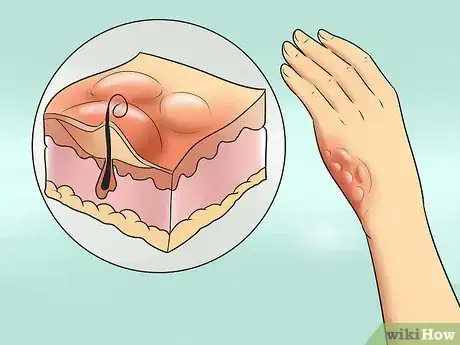
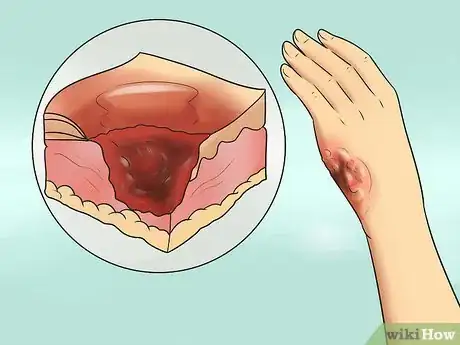
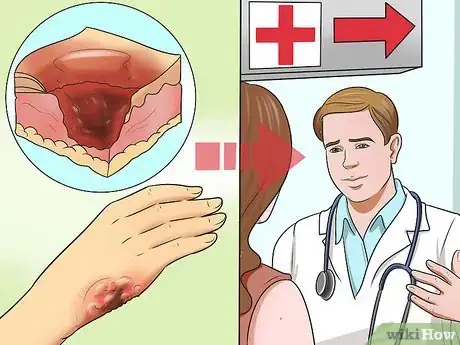
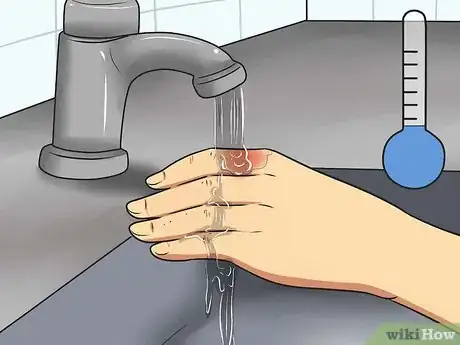

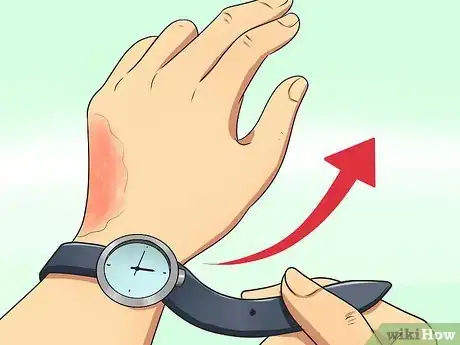


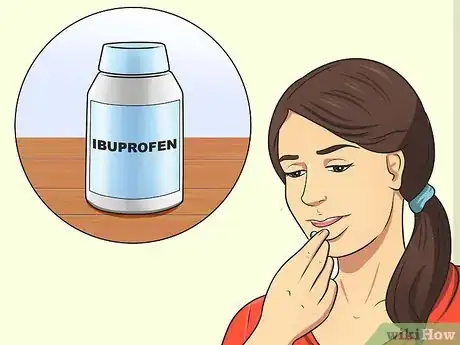
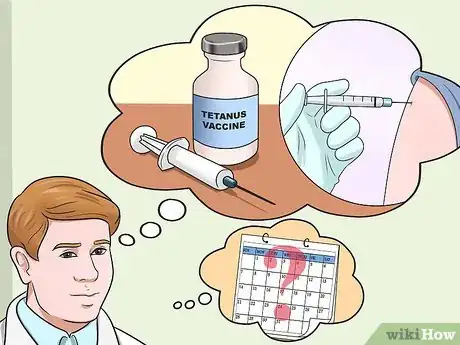
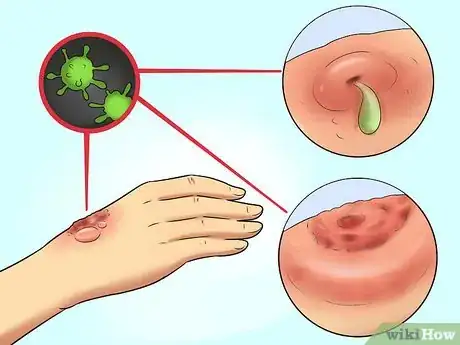
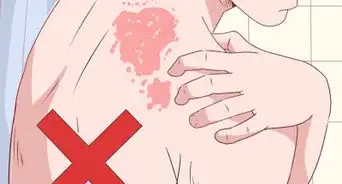





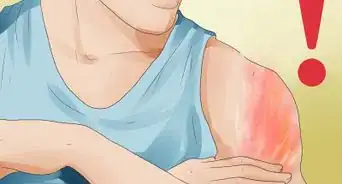

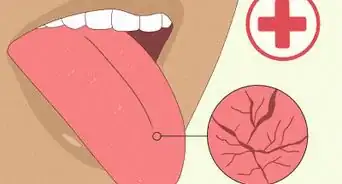

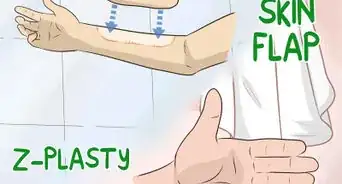
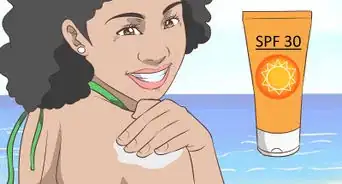

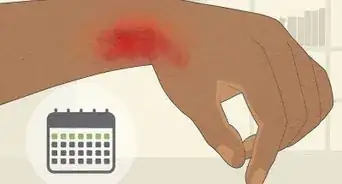









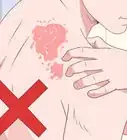

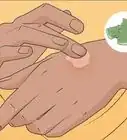




































Medical Disclaimer
The content of this article is not intended to be a substitute for professional medical advice, examination, diagnosis, or treatment. You should always contact your doctor or other qualified healthcare professional before starting, changing, or stopping any kind of health treatment.
Read More...